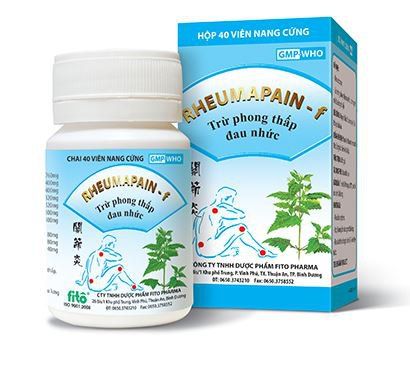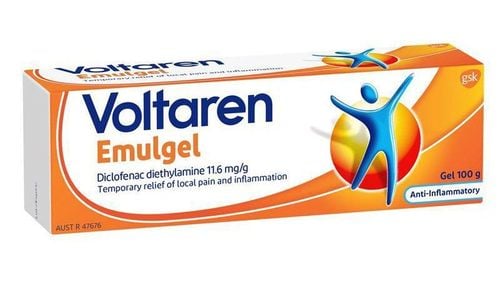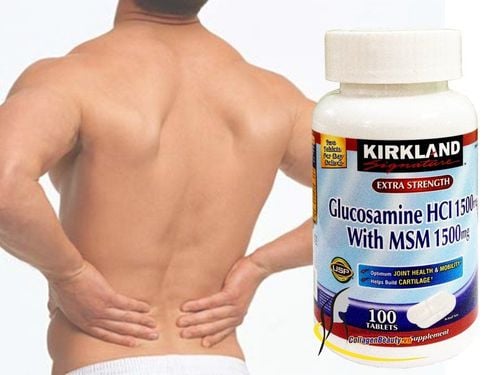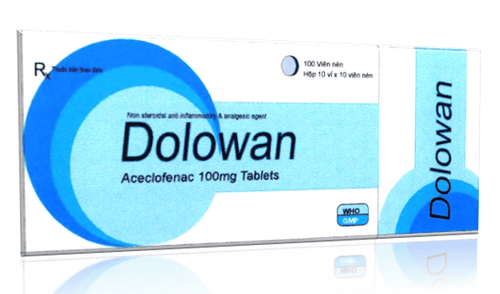This is an automatically translated article.
Volgasrene is made in the form of enteric coated tablets, the main ingredient is Diclofenac. Let's learn about the use of Volgasrene through the sharing article below.1. What is Volgasrene?
Volgasrene contains the active ingredient Diclofenac sodium 75mg. The drug is prepared in the form of enteric-coated film-coated tablets and is manufactured and distributed by NIC Pharma NIC Pharmaceutical Commercial Production Co., Ltd. Volgasrene has the registration number VD-17277-12.2. Indications for the use of the drug Volgasrene
Volgasrene belongs to the group of prescription drugs and is prescribed by a specialist. Therefore, the patient should take the drug as directed by the doctor, usually Volgasrene is indicated in the following cases:Long-term treatment of chronic arthritis, degenerative joint disease. Patients with primary dysmenorrhea. Treatment of acute pain (post-traumatic inflammation, swelling) and chronic pain.
3. How to use and dosage of Volgasrene
3.1 How to take the drug Volgasrene Volgasrene is used orally with a sufficient amount of water. Volgasrene drugs used in long-term treatment need to calculate the dose carefully, depending on the needs and response of the patient's body and should be used from the lowest dose until effective.3.2 Dosage of Volgasrene for treatment of ankylosing spondylitis: Take 1 tablet each time, 1 to 2 times/24 hours. Treatment of osteoarthritis: Take 1 tablet x 2 times/24 hours. Treatment of joint damage: Take 1 tablet every 24 hours in the evening. Treatment of rheumatoid arthritis: Take 1 tablet x 2 times/24 hours.
4. Contraindications to the use of the drug Volgasrene
Volgasrene is contraindicated for use in some cases as follows:Patients with hypersensitivity to Diclofenac, Aspirin or other non-steroidal anti-inflammatory drugs (with manifestations of asthma, rhinitis and urticaria after taking Aspirin). Patients with advanced gastric ulcer. Patients with asthma or bronchospasm, bleeding, cardiovascular disease, severe kidney failure or severe liver failure. The patient is being treated with Coumarin. Patients with congestive heart failure, volume depletion due to diuretics or renal failure. People with gum disease.
5. Unintended effects when using the drug Volgasrene
During the use of Volgasrene, patients may experience some side effects as follows:Common: Headache, tinnitus, epigastric pain, nausea, restlessness, vomiting, diarrhea or distension abdominal pain, anorexia, dyspepsia and increased transaminases in the liver. Uncommon: Edema, allergy, anaphylaxis including hypotension, rhinitis, urticaria, abdominal pain, gastrointestinal bleeding, somnolence or insomnia, somnolence, depression, anxiety, blurred vision and Dark spots, eye pain. Rare: Edema, alopecia, rash, Stevens-Johnson syndrome, possible gallbladder contractility. Usually these side effects go away when you stop taking Volgasrene. But to be on the safe side, inform your doctor or medical person immediately if you suspect any side effects of Volgasrene that you experience.
6. Volgasrene drug interactions
Drug interactions can increase or decrease the effects of Volgasrene. Therefore, Volgasrene should not be combined with the following drugs:Oral anticoagulants and heparin combined with Volgasrene: Risk of severe bleeding to the user. Volgasrene in combination with Quinolone antibiotics: May lead to convulsions. Volgasrene combined with Aspirin or Glucocorticoid: Reduces blood levels of diclofenac and increases the risk of gastrointestinal damage. Volgasrene in combination with Diflunisal: May increase blood levels of diclofenac and may cause very heavy bleeding in the gastrointestinal tract. Volgasrene in combination with Lithium: Diclofenac may increase serum lithium concentrations to toxic levels. Volgasrene in combination with Digoxin: Diclofenac may increase serum digoxin concentrations and prolong the digoxin half-life. Blood levels of digoxin should be checked and the dose of digoxin reduced if both drugs must be combined. Volgasrene in combination with Ticlopidine: May increase the risk of bleeding. IUDs may interact with Volgasrene. Volgasrene in combination with Methotrexate: May increase the toxicity of methotrexate. To ensure safety, patients should inform about all drugs and supplements they are using so that the doctor can provide the safest and most effective treatment regimen.
7. Volgasrene overdose and treatment instructions
An overdose of Volgasrene will make the side effects worse for the user.Treatment of Volgasrene overdose: Treatment is mainly focused on causing vomiting for the patient or gastric lavage, activated charcoal can be used to help reduce drug absorption in the gastrointestinal tract and hepatobiliary system.
8. Be careful when using Volgasrene
Some subjects need to be cautious when using Volgasrene such as:People with a history of gastrointestinal ulceration, bleeding or perforation of the gastrointestinal tract. People with kidney disease, liver failure and systemic lupus erythematosus. People with high blood pressure or heart disease have fluid retention or edema. People with a history of liver disease. Liver function should be checked periodically during prolonged treatment with Diclofenac. Infected person. The patient has a history of coagulopathy and bleeding. People driving, operating machinery or doing concentrated work should be careful when using because Volgasrene causes dizziness. In short, Volgasrene is a prescription pain reliever that patients should not use without a doctor's prescription. In the process of taking the drug, if you have any questions or problems, please inform your doctor for advice.
Please dial HOTLINE for more information or register for an appointment HERE. Download MyVinmec app to make appointments faster and to manage your bookings easily.













